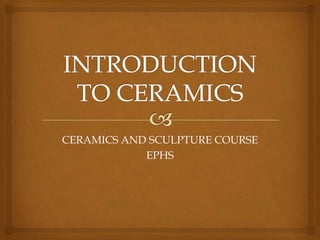
Introduction to ceramics
- 1. CERAMICS AND SCULPTURE COURSE EPHS
- 2. Clay Clay is formed by the decomposition of rock through the action of weathering. Impurities, such as sitcks and leaves are taken out and the clay is then packaged for our use. If interested, you can dig up and purify your own clay: http://www.ehow.com/video_4946364_using- natural-clay-pottery.html
- 3. Wedging Kneading the clay with fingers and the heel of the hands in a rocking spiral motion, forces out trapped air pockets and helps to distribute moisture evenly throughout the clay.
- 5. SCORING • SCORING is the best way of attaching one piece of clay to another. • If clay is not properly scored, it will fall apart either when drying or during the firing process.
- 6. SLIP SLIP is liquefied clay. Slip is applied to scored surfaces and acts as a sort of “glue” onto attach one piece of clay to another.
- 7. Hand building Three Methods… All Ancient…
- 8. PINCH POTS PINCH POTS are formed by quickly pinching and turning a kneaded ball of clay. One of the most simple hand building techniques.
- 9. COILING COILING is an ancient hand building method in which walls are constructed with and rolled, rope-like pieces of clay. The joints are then smoothed over to create one solid piece.
- 10. SLAB ROLLLING Hand Rolled Here. Use of Slats Important! Slab construction is another rand building technique, in which the clay is rolled out onto flat pieces. The slabs are usually an even, consistent thickness and are then cut, scored, slipped and joined together. Best at the LEATHERHARD stage.
- 11. STAGES OF CLAY
- 12. SLIP Slip: Watered down clay in muddy form.
- 13. Plastic Workable wet stage; molding stage; can recycle. At this point, it can still be joined to other pieces.
- 14. Leather-Hard Stiff and will hold its shape; can still be joined to other pieces. May be carved into. Can still be recycled.
- 15. Greenware Bone-dry; can be carved into; VERY FRAGILE. Can still recycle. Kiln ready.
- 16. Bisqueware Fired once in the kiln. CAN NOT BE RECYCLED. Glazing/Surface Treatment Stage.
- 17. Glazeware Result of a second firing. Completed if item is glazed.
- 18. KILN • Furnace used for “firing” greenware/glazed bisqueware. • In order to become permanent, clay must be fired at very high temperatures in a kiln. • We fire anywhere from 1800-2400 degrees Fahrenheit.
- 19. After seeing each technique modeled by the teacher, you will create a small pot utilizing each of the three outlined handbuilding techniques. (PINCH, COIL, SLAB)
- 20. IMPORTANT to REMEMBER!! The Ten Golden Rules of Ceramics Clay must be thoroughly covered up with a plastic bag to keep it from drying out. This applies to works in progress and moist clay. Clay dust can be harmful if you are exposed to it for long periods of time, so keep your area clean, clay scraps off the floor and clean with water and a sponge. Clay can be no thicker then your thumb. In order for clay to stick together it MUST be scored and slipped together while the clay is moist or leather hard. Wedge clay to remove air bubbles, achieve uniform consistency, and to line up the particles of clay. Trapped air can cause clay to explode. So hollow out sculptural forms and put needle holes from the bottom so air can escape. Don't glaze the bottom of a piece. Always wash the piece before glazing. Always handle your project with two hands at all times. In other words BE CAREFUL it’s your hard work. Never lift pots by the rim. NEVER HANDLE ANOTHER PERSONS WORK EVEN IF IT LOOKS COOL!
